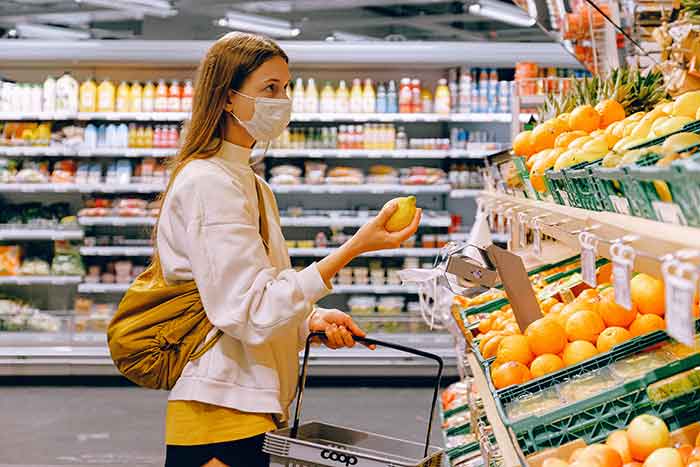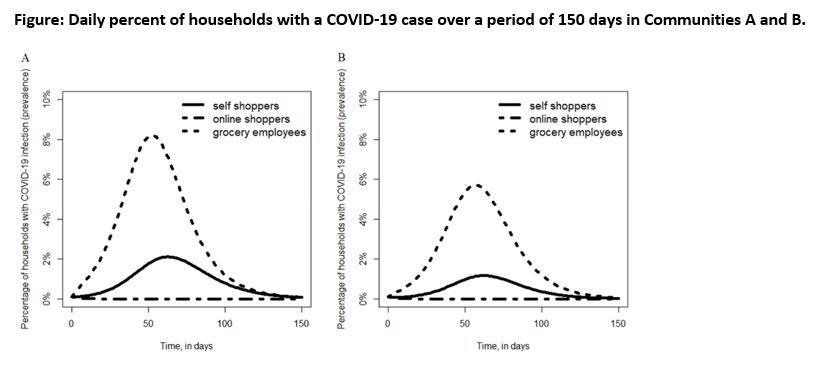Grocery Shopping in the Time of COVID-19
June 4, 2020

During the COVID-19 pandemic, people still need groceries. Many people continue to go to the grocery store but say that they do shop less often than before COVID-19 and that they are careful to practice ‘social distancing.’ Some people add that they don’t feel comfortable letting others shop for them because it would mean shifting the COVID-19 risk to someone else.
But from a community point of view, what would happen to COVID-19 infection rates if more households used only online shopping with curbside or delivery services? This change would lead to fewer people entering grocery stores and could reduce the chance of coronavirus spread in the grocery store environment. The risk of COVID-19 could be reduced for shoppers, grocery store employees, and the community overall. The one caveat, to accommodate an increase in online shopping with curbside or delivery, the number of grocery store employees (or people employed fulltime shopping for others) would increase, putting more people in this ‘higher risk’ pool.
To show this more clearly, we developed simple mathematical models that compare rates of COVID-19 infection in two Communities, A and B. The communities are identical in every way except for household grocery shopping habits during the pandemic. Shown in the table below, Community A has a larger percent of households doing their own shopping, 79%. Community B has a larger percent of households using only online shopping with curbside pickup or delivery, 70%, and has more households with grocery store employees to accommodate the greater demand for online service.

In this example we focus only on exposure to the coronavirus of COVID-19 at grocery stores over a period of 150 days, either through close contact with a COVID-19 positive person, an airspace with virus or a contaminated surface. Of course, grocery stores are not the only opportunity for coronavirus exposure and many people are exposed through other workplace settings. However, we had no evidenced-based estimates for what the different risks of COVID-19 might be for each household group outside the grocery store during the 150 days, therefore we set that risk at zero.
Our models, which are commonly used in infectious disease epidemiology, [1] track the number of people susceptible to COVID-19, or spreading the infection, or recovered from infection over the 150 days. To make these models work we have to add some assumptions: 1) COVID-19 case can infect others for an average of 5 days; 2) COVID-19 cases are immune to reinfection during the 150 days; 3) at the beginning, 0.1% of each group (i.e. self-shoppers, online shoppers, and grocery store employees) in each community has active COVID-19 cases capable of spreading the virus; 4) ‘R0’ , representing the number of people who are infected by a single COVID-19 case, equals 1.4 and remains constant across the 150 days; and 5) the risk of COVID-19 spread from grocery store employees to online shoppers via curbside or delivery, is zero. In addition, we estimated that a single person working fulltime could, on average, shop for seven households per day, whether employed by the grocery store or by an online shopping service.
After putting all parameters into the models, we estimate the daily percent (prevalence) of households with a COVID-19 case in Communities A and B (shown in the figure below). For both the self-shopper and grocery store employee households, the peak of the graph is lower (smaller percent, ‘curve is flattened’) in Community B versus A. This suggests that by increasing online grocery shopping, communities could reduce the number of COVID-19 cases at any one time and thereby help prevent healthcare settings from becoming overwhelmed.

Equally important, we look at total percent of households (cumulative incidence) with a COVID-19 infected individual over the 150 days (results in table below). As you might expect, grocery store employee households are the group with the highest cumulative risk of contracting COVID-19 in this model, and to accommodate more online shoppers we had to double the number of grocery store employee households from 1% in Community A to 2% in Community B. However, the risk of infection for both households with grocery store employees and with self-shoppers is markedly lower in Community B compared to Community A. If we look across the entire community (combining all three household types), increasing the percent of households using online shopping from 20% (Community A) to 70% (Community B) reduces the percent of households with COVID-19 infections from 21% to 5%. This means that online shopping had about a fourfold positive impact on community infection rates compared to self-shopping in this model.

To keep this example simple, our models don’t include other factors that might affect an individual’s likelihood of exposure to the coronavirus in a grocery store such as time of day one enters the grocery store, duration of shopping time, and level of precautionary measures, e.g. hand washing, social distancing, monitoring temperature and symptoms, disinfecting surfaces, using face masks, and regular testing for COVID-19 with follow-up isolation and quarantine of contacts. One thing to consider however, we may have little control over the level of precaution taken by other people in the store.
The R0 value we used in modeling is from a recent source on community COVID-19 spread[2] and may be high for our specific example. R0 can vary across environments and we have no direct measures from grocery store COVID19 spread. If we change the parameters in our models, the absolute numbers and percentages change, however, the patterns of infection rates across household shopping types and across the two communities persist. Despite the simplicity of our mathematical models, at a fundamental level our conclusions are consistent with what we know about this highly infectious coronavirus. If you decrease the number of people intersecting in shared spaces, e.g. grocery stores, you could reduce the spread of the virus and the total number of people in the community who are infected. Bottom line, by not entering the grocery store, shoppers lower their own risk of COVID-19 and lower the risk for grocery store employees.
We recognize that many households may not have access to online grocery selection; it would be helpful if other options could be made available, such as telephone orders. In addition, accommodating a significant increase in online grocery shopping during a pandemic like COVID-19 is not a trivial task. It requires altering logistics and being sensitive to grocery store resources, employment arrangements for ‘extra grocery store employees,’ the number of shoppers for online services, and the different needs of the households they serve. Nonetheless, if those who are able use online services more frequently for their shopping needs, it could reduce the risk of infection for everyone in the community.
The example provided here tells us we should be very grateful to grocery store employees who put themselves at greater risk of contracting COVID-19 while working to provide us with food. One way to show our thanks is to help grocery store employees reduce their infection risk: we can pursue online shopping options, support precautionary measures for grocery store employees, and use greater precaution if choosing to enter the grocery store.
Finally, as parts of the U.S. begin relaxing ‘shelter in place’ restrictions and move toward opening more public spaces, one might ask if community planning for online grocery store shopping is still relevant. We think so for the following reasons. The coronavirus is still ‘out there’ and we have not achieved ‘herd immunity’ or vaccine protection. No one knows when areas spared to date might become new ‘hot spots’ for COVID-19. Similarly, no one knows if previously affected areas will experience second waves of COVID-19 once people move about and interact, or seasonal changes and indoor congregating increase coronavirus spread. Therefore, it seems prudent to consider all opportunities for limiting coronavirus exposure, particularly if that can be done practically and with minimal economic downside. Obtaining groceries is unique; unlike a doctor visit, haircut, or a car purchase, once groceries are selected online, others can pull and bag groceries without the ‘shopper’ being present. Grocery stores are unique in that they thrive, whether we shop ourselves or have online shopping systems operating through the grocery.
In conclusion, while we have no direct data to quantify COVID-19 spread through grocery store exposure, our mathematical example suggests communities could use online shopping as a means of exercising precaution and protecting employees and shoppers, with minimal sacrifice to the consumer and the business.
1. Hethcote HW. 1989. Three basic epidemiological models, In Levin, Hallam, and Cross (Eds.) Applied Mathematical Ecology. Biomathematics, Vol. 18. Springer-Verlag Berlin Heidelberg, New Your, pp 119-143.
2. Kissler et al., Science 10.1126/science.abb5793 (2020)
Epidemiologists at Michigan State University: Claudia Holzman, DVM, MPH, PhD and Lixin Zhang, PhD, from the Department of Epidemiology and Biostatistics, Guoli Zhou MPH, MD, PhD, from Clinical and Translational Sciences Institute

